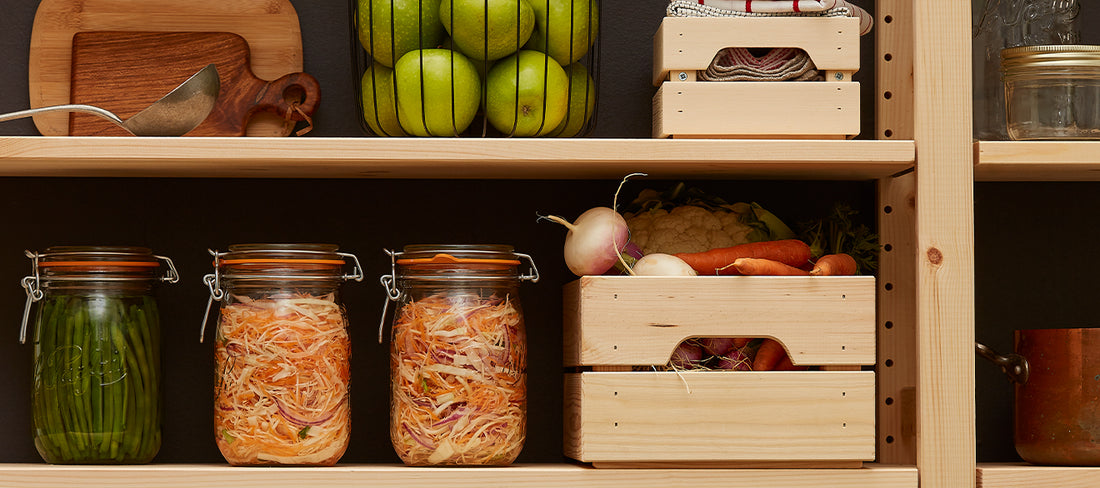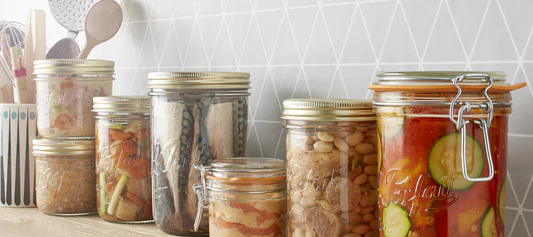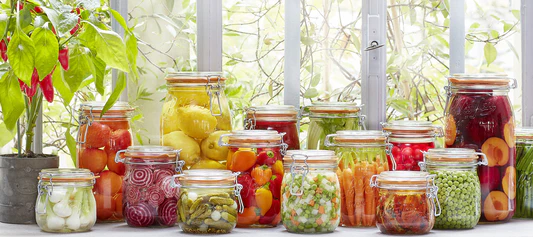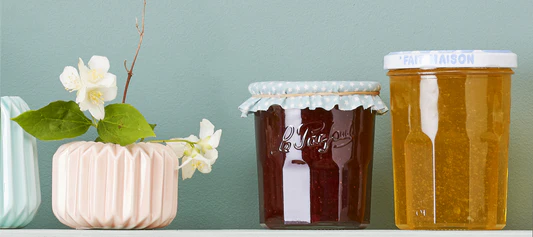
THE ABC OF FERMENTATION
You don't need a Michelin star to master fermentation. The process happens naturally. It’s all down to microorganisms, most of which can be found in vegetables. Then, all you need to do is provide an environment which encourages lactic acid to be created. This is achieved quite simply by following the instructions and using thoroughly cleaned jars, a little elbow grease and a few ingredients!
7 HELPFUL TIPS
1/7
PREPARING YOUR LE PARFAIT JARS
Make sure your jars have no chips, scratches or sticky residue on them. Clean the jars with hot, soapy water. Try not to knock the jars against each other. Do not use a wire or abrasive sponge to clean your jars. After cleaning, rinse the jars thoroughly with warm water and then leave them to dry in the open air.
2/7
PREPARING YOUR VEGETABLES
Choose organic or pesticide-free vegetables, and if they're not dirty, a quick splash of water will do. Do not wash them using any antibacterial products because, as we mentioned earlier, the microorganisms found on the vegetables are essential! Some thick-skinned vegetables can also be peeled!
3/7
CHOOSING THE RIGHT JAR AND THE BEST SIZE
The perfect jar for perfect fermentation is the Le Parfait Super jar. Choose your jar size depending on the quantity of vegetables you are using. In fact, to successfully preserve the food, it is important to fill the jar up to 2cm from the rim. Any lower than that and it is possible that the fermentation process won’t take place and mould will develop.
4/7
EACH VEGETABLE HAS ITS OWN FERMENTATION METHOD
Vegetables with a high water content, such as courgettes, should be sliced thinly (julienne style, grated, etc.) and are best prepared with salt. Vegetables with a lower water content should either be fermented whole or coarsely chopped and are prepared in brine.
5/7
GETTING THE RIGHT PROPORTIONS
The first rule to follow is that the salt content should be 1% of the entire mixture (i.e. vegetables + water). That way, it shouldn't be too salty when you taste it.
If you are only using salt in your fermentation process, the correct ratio is 10g of salt per kilo of vegetables.
If you are using brine (water and salt mixture), the correct ratio is 30g of salt per litre of water.
The science bit: What is the purpose of the salt? In addition to releasing the juice from the vegetables and preserving their crunchiness, salt is also a super pathogen inhibitor.
6/7
TEMPERATURE
Ferments, just like us, do better in mild temperatures. Consequently, an ambient temperature that does not fall below 20°C for the first few days is best. Then, once the process has started (when your jar starts singing*) it can be placed somewhere cooler.
Ferments, just like us, do better in mild temperatures. Consequently, an ambient temperature that does not fall below 20°C for the first few days is best. Then, once the process has started (when your jar starts singing*) it can be placed somewhere cooler.
Marie-Claire Frédéric, author of the must-read blog Ni cuit ni crut (Neither cooked nor raw), fermentation expert and owner of the Suri restaurant, advises that fermented foods should not be put in the fridge, “because the storage temperature has an impact on the taste. The warmer it is, the sourer (and even more acidic if it is very warm) and stronger the flavour. For delicate flavours, ideally store at cellar temperature: 12°C to 15°C.”
However, if you notice the fermentation process is happening too quickly, or if you want to stop it at a specific point (depending on taste), of course you can pop it into the fridge for a little while.
* Yes, you read that correctly, the jars sing. Or rather they whistle around the rubber ring. This is completely normal and even a good sign! After one or two days, the liquid will become slightly cloudy and effervescent; a white or greyish residue may appear. This is nothing to worry about, it's just the dead yeast settling in the jar.
7/7
A TASTY RESULT TAKES PATIENCE
Be careful not to open your jar during the fermentation process! You need to wait at least 16 days before tasting (the day you started the fermentation process + 2 weeks) unless otherwise indicated in the recipe. But, as a general rule, 4 to 6 weeks will give you the best flavour result. After that, if you want to keep your closed jars for a long time (sometimes for years), store them in a cool, dark place, like a cellar for example.
But for those with impatient taste buds, after the initial 16 days, you can open and enjoy! How can you tell if the fermentation been successful? A good sign is if there is no bad smell. If you notice a really bad smell, you’ll need to do the process again. If not, you’re in for new treats! And, if you manage to not scoff it all at once, keep your jars in the fridge between 4°C to 6°C. To ensure the vegetables remain bathed in the brine, you might also want to weight them down.




